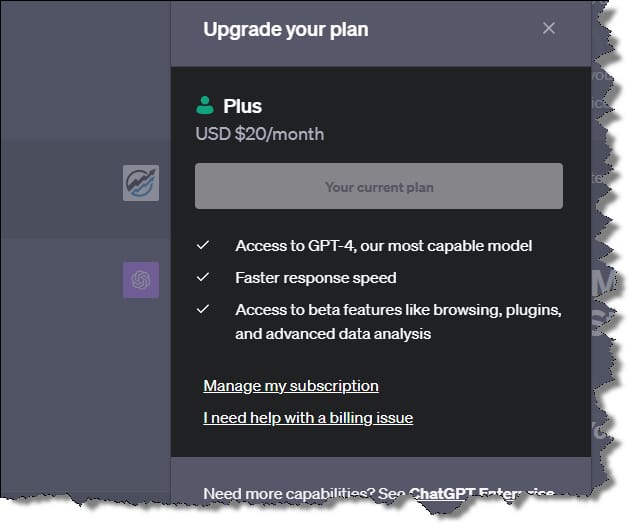Howdy and welcome back. Doug here, and yesterday I watched 7 hours of the best videos on YouTube about new ChatGPT hacks.
Everything I watched was less than a week old and I was delighted and shocked that I could CLONE MYSELF with ChatGPT!

Cloning myself with ChatGPT (image by author)
ChatGPT Applications Are Exploding
I’ve been using ChatGPT for months so when I started watching the latest top videos on YouTube I wasn’t expecting to find anything new.
But wow. I was wrong!
While many of the videos about ChatGPT were just hype with the same old, same old - there were some fantastic new insights and just new capacities that I had not studied!
And I’m super excited by what I found. I collected the best into a spreadsheet and then I started using and testing the tools and tips… making screenshots for these tutorials as I was going!
At first, I wanted to share a short list of the best AI Chat tips that I found but it soon became clear that I will need to group them into batches.
Clone Yourself With ChatGPT

Create better quality content with AI (midjourney image by author)
This is the first of three tutorials for ChatGPT that will build on the essentials that every user should be using.
Whether you're a small business owner, a content creator, or just someone looking to get the most out of AI, this tutorial will power you up to a new level and leap-frog you over your competition.
And there’s just no goin’ back.
So, let's get started!
5 Steps To Clone Yourself Like a ChatGPT PRO
Time to Level Up Your ChatGPT Game
Alright, let’s really get the most out of ChatGPT.
This isn’t about producing greater quantities of low-budget content.
Instead, this is about creating better quality, more enriching content that used to take an entire production team to accomplish! Now, we can create amazing effects with a small set of AI Tools, and, I save the best till the end.
The first part of the secret sauce is using custom instructions to begin cloning yourself… well, that means you are cloning your writing style.
You can find the custom instructions by clicking on your profile icon in ChatGPT.
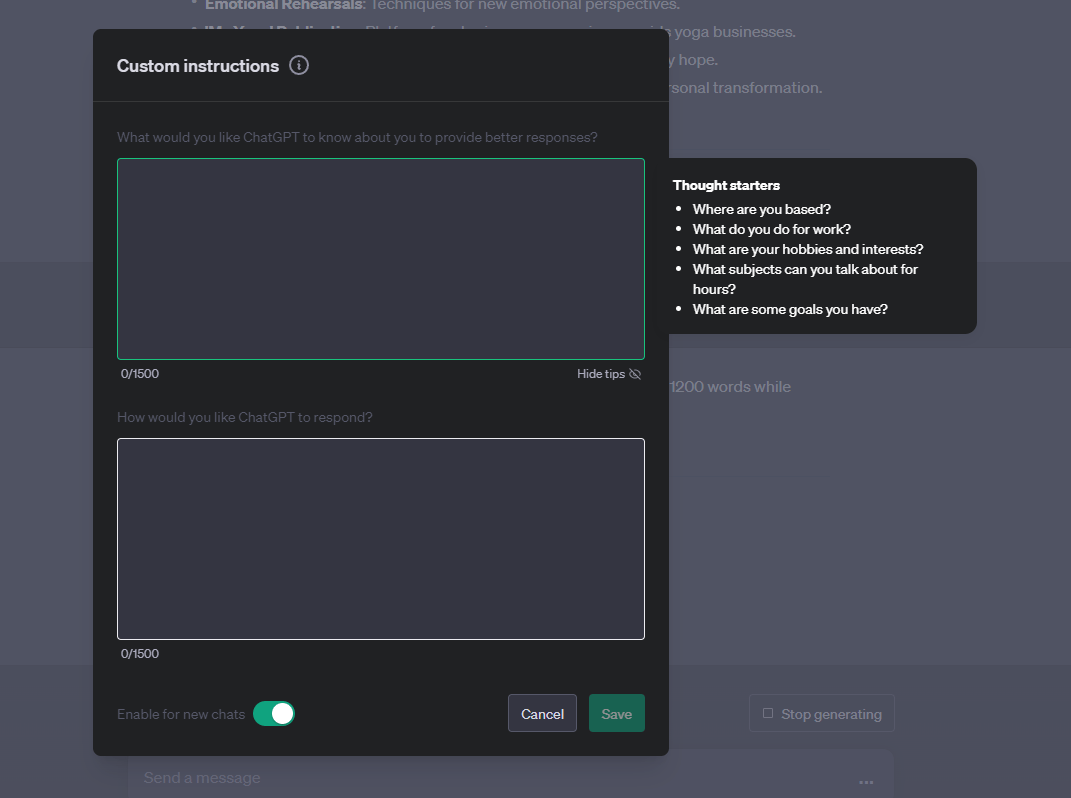
Setting up Custom Instructions in ChatGPT (image by author)
Why Does It Matter?
Think of it this way… Imagine you're at an extended board meeting and you are working through lunch. If you had a well-trained assistant you would just say, "Please bring me lunch," right? And they would already have it ready.
They already know what you want and they anticipate it.
The same goes for ChatGPT.
Custom instructions are like having that kind of tailored experience. You can tell ChatGPT about your profession, your preferences, and how you'd like it to respond. It's like having a personal assistant who knows you well.
ツ Realtime Example
At the end of this tutorial, I demonstrate how My Clone actually created a really great and detailed post with the very prompt sequence you will learn below.
(The example article below was published on October 12 2023 and I’ll update this case study over the months to come.)

Pick a Clone - any Clone! (midjourney image by author)
Let’s SET UP the POWER of Your Writing!
➤ Part 1 First Panel of the Custom Instructions
So, the first thing is: ChatGPT has to to know about you in order to create the best quality Clone and to provide responses that match your writing style. The more you can provide context about yourself, the better your clone will be.
I wasn’t sure how to write something about myself when I started setting up my first custom instructions. So I gathered all the ‘about me’ pages into a text file, and then I directed ChatGPT to create a 1400-character summary of all the documents.
Please review the collection of 'about me' pages. I want you to reorganize and rewrite it into a new biography page with the most repeated themes first. Create a 1400-character summary.It was a delight to read my own bio and only took a few minutes of editing to brush it up.
I soon realized that I could create a different ‘writing voice’ for each of the projects that I was writing for and I started to organize my Custom Instruction sets in the MindMap that I mention at the bottom of this post.
▻
➤ Part 2 Second Panel of the Custom Instructions
You can tell ChatGPT about your profession, your preferences, and how you'd like it to respond.
Here is a prompt for creating a tutorial format:
Briefly introduce the Specific Area of focus for today's AI Business Plan. State the problem many small businesses face in this area. List what the 3-hour service package aims to achieve for the Specific Area.
Explain why upgrading this Specific Area is crucial for small businesses. List three benefits the business owner can expect and how they address the problem stated in the introduction. Share a short case study or testimonial if available.
Create a detailed description of what the 3-hour service package for a Specific Area includes. A step-by-step guide to complete the 3-hour service package in a Specific Area for your own business in one evening. Links to blog posts, case studies, or other resources related to the Specific Area.
Share 2-3 quick stats that businesses can check on immediately, serving as a teaser to see how important it is to get started on this three-hour task in this Specific Area as soon as possible.
Discuss the cost of the 3-hour package vs the long-term benefits in the Specific Area. Provide an estimate of the ROI, backed by data if possible.I’ve focused on using the second panel to format the content output in a specific way.
With different sets of custom instructions, articles from particular newsletters will keep a similar organization and tone for all the issues.
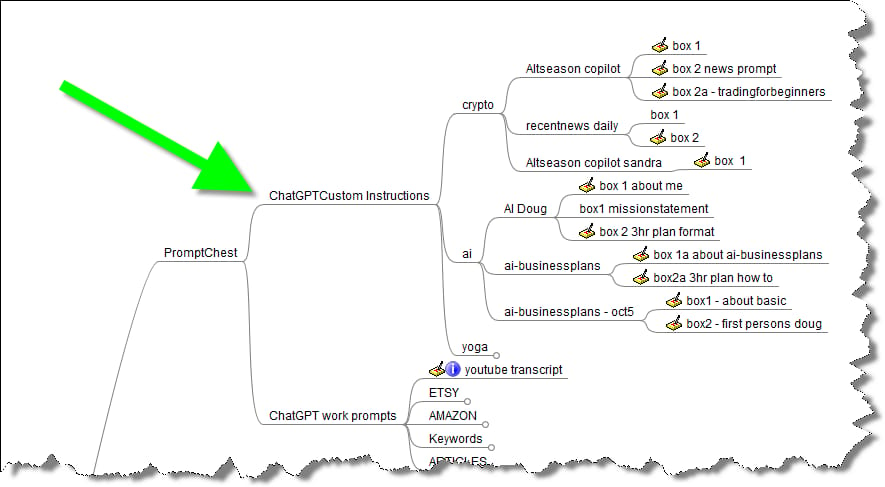
Early Organization of Different Custom Instruction Sets (image by author)
For example, you may submit articles to many different publications on Medium and create a specific set of custom instructions to ensure your articles match the theme of the publication.
NOTE TO SELF: Now I always double-check if my custom instructions to be sure I have the correct instruction set installed and that they are enabled!
DON’T FORGET: Sometimes I’ll disable the custom instructions depending on the work I’m doing.
▻
➤ Part 3 - Be Confident in Your Clone
Did you know ChatGPT can tell you the confidence level of its answers? This is super useful, especially when dealing with factual topics. Many of my custom profiles ask it to provide a source URL for its answers. How cool is that?
Just go to your custom settings and add this feature. It's like adding an extra layer of trust to your ChatGPT interactions.
For any factual information you provide, please include a credible source link. If you're offering speculation or a prediction, kindly let me know.While this prompt does tune up the answers from ChatGPT,
➲ I’ve also been happy with results from Writesonic and Cohesive and use them daily.
➲ Watch for new tutorials as I test the free Taskade Writing Assistant.
▻
➤ Part 4 - The Final Step to Clone Yourself
You want ChatGPT to sound like you, not some generic AI, right? Well, you can actually teach it to write in your style. Just provide some examples of your writing, and voila, ChatGPT will adapt.
I’m going to teach it to write in my own style by giving it some examples.
Here is the prompt that I used:
I'd like you to help me write articles for my productivity blog. First, I want you to understand my writing style based on the examples that I give you. You'll save my writing style under 'MY_STYLE'. After that, I'll tell you when to write the article using MY_STYLE.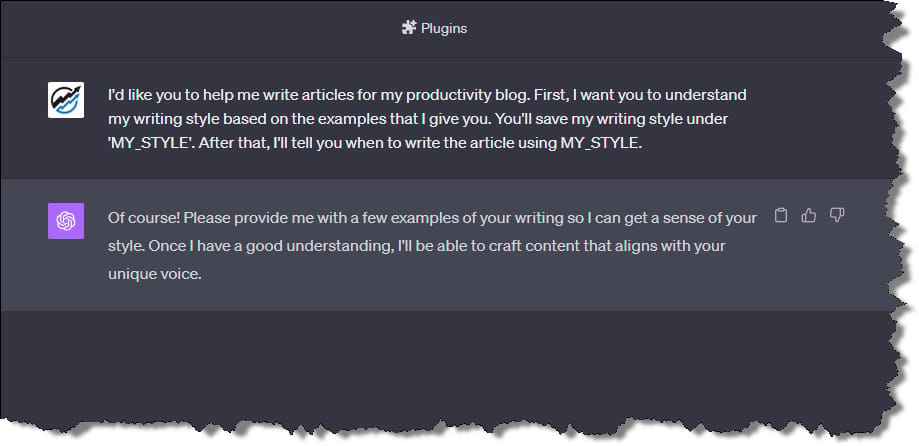
Training AI to Write Like Me
Here was the reply from ChatGPT after I shared some articles:
Thank you for sharing your writing sample. Based on what you've provided, here's a breakdown of your writing style:
Informative and Detailed: You provide a lot of specific information, including step-by-step guides and tools to use.
Conversational Tone: Your writing is friendly and approachable, making it easy for readers to connect with.
Use of Imagery: You often refer to images or visual aids to help illustrate your points.
Personal Anecdotes: You weave in personal stories and experiences to make your content more relatable.
Engaging Hooks: You use hooks and questions to keep readers engaged and curious.
Humor: You sprinkle in light humor, like the pun about the "hungry market for cookbooks."
CTAs and Prompts: You often guide the reader on what to do next, whether it's using a tool, following a step, or prompting them with a question.
I've saved these characteristics under 'MY_STYLE'. When you're ready, let me know the topic you'd like an article on, and I'll craft it using your unique voice and style.
Here’s a screenshot of the reply. Makes me wonder where my writing might fit in something equivalent to a Myers-Briggs Personality test for writing styles.

Clone Testing: Putting The Clone To The Test
Now that the custom instruction panels are set up, and I’ve completed training the ai with examples of my writing, I can use a simple prompt to develop a detailed and informative step-by-step guide.
After setting up the custom instructions and training the AI with my writing,
This is the prompt I used:
Please create an article about how to train ChatGPT to write in your own voice with 'MY_STYLE'
Here Is The Clone’s Article!
It took me about 20 minutes to edit, format, add links and create Midjourney images to complete the post and publish!
Check it out and see if you can tell.
▻
⟩ ⟩ ⟩›› Human Bonus: Proofreading Your Real Self

Writing with anyone editing with a critical review. (image by author)
Most of the time I create my articles through manual typing on a keyboard and through voice-to-text. My clone is a good writer and I like my clone - but I still can’t plug it into my brain. Yet.
So I have to write new ideas and new tutorials from within my head.
And forever until now, I didn’t have an editor who would go through my article with the details of a University English professor grading a mid-term essay.
I was kind of winging it
…and didn’t know how bad I was.
But recently I’ve been having a lot more success with my writing and it is not an accident. You can do it too. I’m writing these guides as I’m learning the tools so you can follow along as well.
⟩ ⟩ ⟩›› Two Article Review Prompts
Using ChatGPT as a writer’s critic has been a quick way to improve my writing with AI Tools without using AI Tools to write my articles.
Please review the article based on the following criteria:
Story Content:
Enrichment: After reading the article, do you feel enriched? Did the story evoke emotions such as laughter, tears, excitement, wonder, or any other strong feeling?
Value to the Reader: Does the story respect the reader-writer relationship, ensuring the reader doesn't feel they've wasted their time on a sales pitch or a mere bid for attention?
Originality: Is the content original, presenting a fresh perspective or shedding new light on a known topic? Ensure the story doesn't seem like it's generated by a text-generating tool.
Author’s Experience:
Relevance: Does the author demonstrate credible, first-hand knowledge or experience on the subject?
Authenticity: Is there a clear reason why this specific author is discussing this particular topic? Do their insights reflect genuine experience, whether in a fictional or non-fictional context?
3. Craftsmanship:
Quality of Writing: Is the article well-written, error-free, and sourced appropriately? Is the narrative strong and compelling?
Clarity: Are the content, editorial choices, and main point of the article clear?
Length: Is the length of the article appropriate for its purpose and context?
Title: Does the title accurately represent the content without resorting to clickbait? Does the article deliver on the promise of its title?
Visuals: If the article includes images, do they enhance the story? Ensure they have ALT text for accessibility and are credited appropriately.
Formatting: Is the formatting used correctly, indicating the writer's attention to detail?
4. Impact:
Resonance: Did the story leave a lasting impression on you? Are you still thinking about it days after reading?
Shareability: Were you compelled to share this article with others?
Value: Did the article make you appreciate the platform it was published on? Were you satisfied with the read?
Please provide detailed feedback for each of the above points, ensuring a comprehensive review of the article.⟩ ⟩ ⟩›› The 5 W’s Article Review Prompt for Writers
Try this ChatGPT Prompt to review one of your articles. Did you find it helpful? I’d love to hear from you.
Story Content:
What: What emotions did the article stir in you?
Why: Why did you feel the article was or wasn't valuable?
Who: Who would find this article original and why?
Author's Credentials:
Who: Who is the author and what makes them credible?
Why: Why is this author the right or wrong person for this topic?
Craftsmanship:
What: What stood out in terms of writing quality?
Where: Where did the article excel or falter in clarity?
When: When did you feel the article was too long or too short?
Who: Who would be misled by the title?
Why: Why did the visuals work or not work?
Impact:
What: What lasting impression did the article leave?
Who: Who would you share this article with?
Why: Why did or didn't you find value in the platform?⟩ ⟩ ⟩›› ChatGPT Prompt for Proofreading
This might be saving the best for last - I’ve already added this to my personal MindMap and I’d be delighted if you were to share this ChatGPT prompt with a friend who might benefit as well.
Act as if you are an expert at Proofreading.
Complete the analysis of this article and create a table with the H1 field names 'Error' and 'Error Count'
Spelling Errors
Grammar Errors
Punctuation Errors
Capitalization Errors
Syntax Errors
Tense Errors
Pronoun Errors
Voice Errors
Style Errors
Diction Errors
Jargon Errors
Colloquialism Errors
Content Errors
Redundancy Errors
Inconsistency Errors
Logic Errors
Clarity Errors
Citation Errors
Formatting Errors
Typographical Errors
When you find errors then give it an H2 sub-heading and show the original and suggested corrections.
This is Article:Does AI Really Help You Make Money?
Maybe you have also read some fantastic claims like these and you wonder if it’s just another clickbait headline.
Businesses that use ChatGPT effectively save up to 20 hours a month.
Content generated by ChatGPT can increase website traffic by up to 30%.
85% of businesses report better decision-making when using ChatGPT for data analysis.
Let’s Do Some Objective Fact Checking
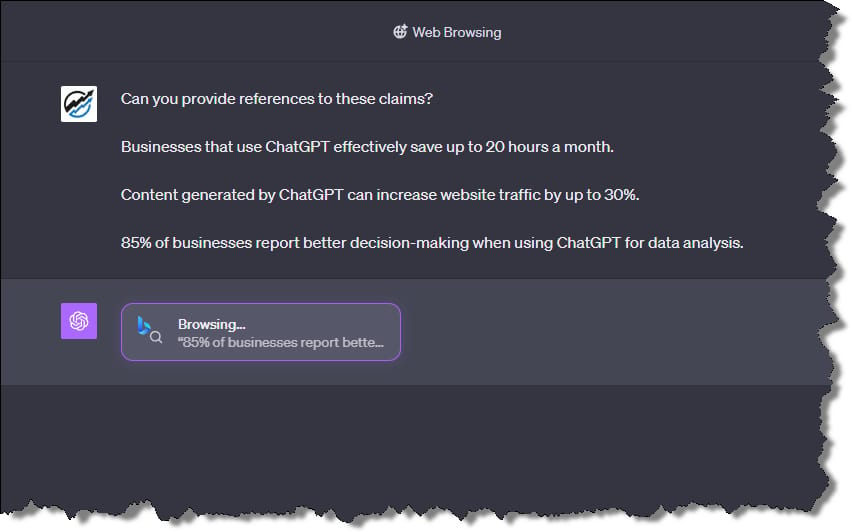
Use ChatGPT Browsing to check facts (image by author)
Turns out, according to ChatGPT, the claims regarding the effectiveness of Artificial Intelligence tools in saving time, increasing website traffic, and aiding in better decision-making in businesses are supported to varying degrees by different sources.
Time-saving:
Increasing Website Traffic:
Better Decision-making:
Although the exact statistic of 85% was not found, several sources discussed the potential of ChatGPT in aiding data analysis and decision-making.
Harvard Business Review highlighted the role of ChatGPT in a successful decision-making process9.
These references provide a glimpse of how individuals and businesses might benefit from using ChatGPT. However, the claims might be based on personal experiences or specific case scenarios, and it's advisable to consider a broader range of sources or official studies for a more comprehensive understanding.
The Investment in Artificial Intelligence:
Cost vs. Benefits
The 3-hour task package for today comes with the cost of your time plus the ChatGPT Plus. When I consider the long-term benefits—to me—it was a no-brainer as soon as I discovered it.
ROI Estimate
Based on my experience, I can create far better content in 20% of the time it once took me.
The difference in my results doesn’t even compare
and I’m really just getting up to speed.
Don’t Miss:
Time for the next steps and unlock the full potential of ChatGPT.
These are some of the hidden secrets to get the most out of ChatGPT.
↳
Recommended Reading
With so many small newsletters with big claims, these are the two that stand out from twenty startups.
Simple AI
➤ Simple.ai offers the Agent AI newsletter, which helps over 100,000 subscribers learn to use AI agents to enhance their careers or businesses. It covers practical insights, strategies, and updates on AI developments, making it easier for readers to stay ahead in the AI landscape. - Read Here.
The AI PMO
➤ The AI PMO provides AI tools, strategies, prompts, and workflows to enhance the efficiency of project management offices (PMOs). Over 634 PMO leaders receive free, practical AI insights every Thursday, helping them to amplify their team's efforts and become AI thought leaders in their organizations. - Read Here.

